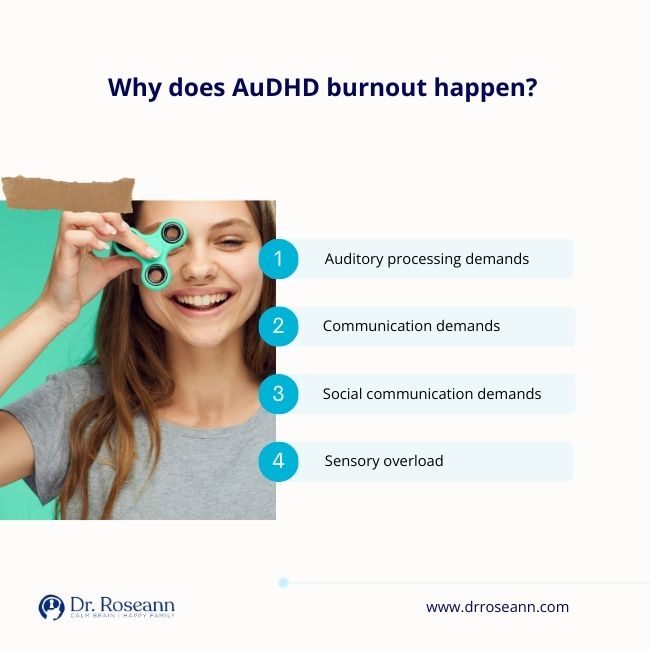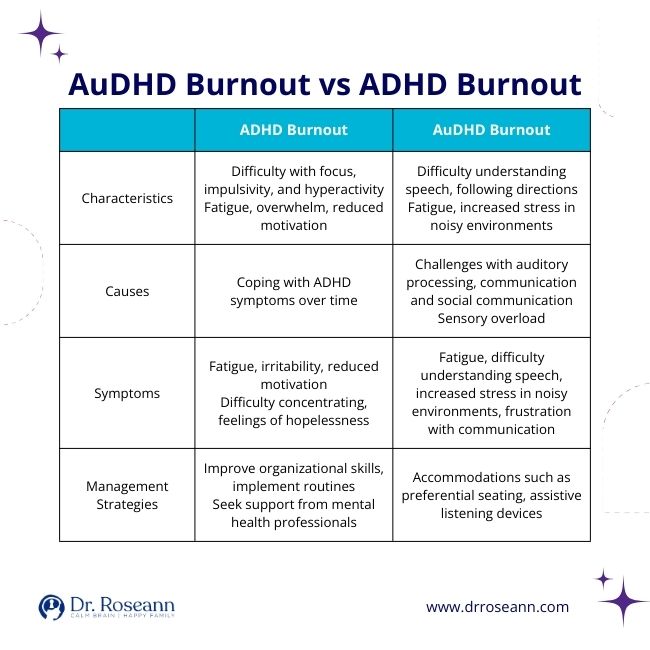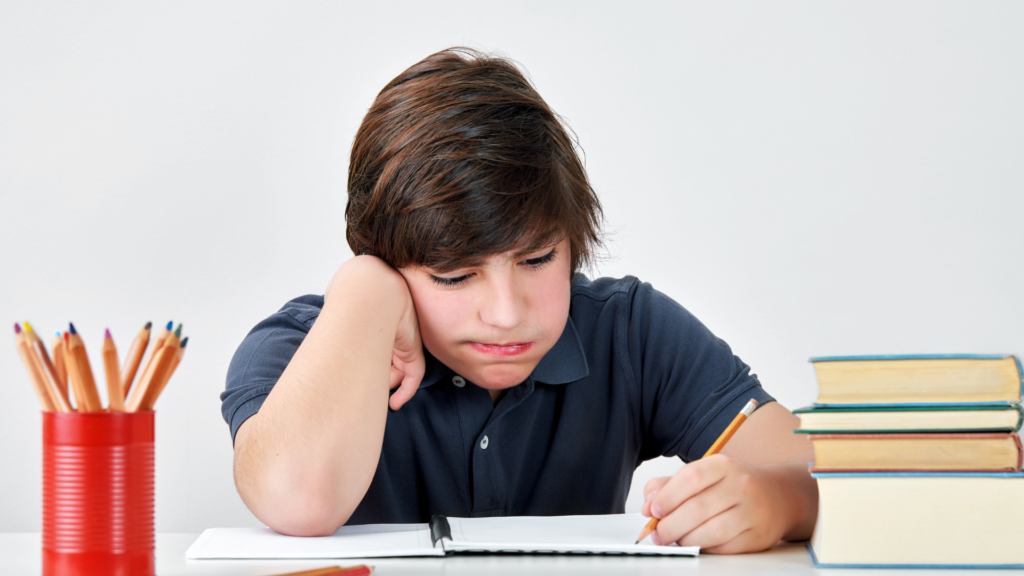AuDHD burnout is an often unspoken and deeply challenging experience for our children. Over the years, I've witnessed firsthand the struggles and triumphs of families navigating the complex terrain of neurodiversity. But what is AuDHD burnout?
When your child brimming with energy and curiosity suddenly becomes withdrawn, irritable, and seemingly overwhelmed by the simplest tasks, it is likely an AuDHD burnout. AuDHD burnout is a state of mental and physical exhaustion resulting from the constant demands of navigating ADHD and Autism.

AuDHD Burnout Symptoms
The presentation of AuDHD burnout can vary widely among individuals, and not everyone will experience all of these symptoms. Even so, the most common symptoms of AuDHD burnout include:
- Fatigue: Your child may appear constantly tired, despite getting enough sleep.
- Social Exhaustion: They may become withdrawn and prefer solitude over social interactions.
- Regression: Skills they once mastered may start to decline.
- Overstimulation: Once manageable Environments may now overwhelm them.
- Masking Burnout: The effort to mask their neurodiversity becomes exhausting.
AuDHD Burnout vs ADHD Burnout
AuDHD burnout differs from other types of burnout in several key ways, primarily stemming from the unique intersection of Autism and ADHD. Furthermore, ADHD burnout and AuDHD burnout are distinct concepts that may share some similarities but differ in their underlying causes and manifestations. Here’s a summary:

How Long Does AuDHD Burnout Last?
AuDHD burnout manifests differently from person to person and can vary significantly in duration. Some children may experience brief episodes lasting only a few days, while others may endure prolonged periods of burnout extending over weeks or even months.
Furthermore, factors such as the intensity of environmental stimuli, the level of support available, and the effectiveness of coping mechanisms all play crucial roles in shaping the duration of burnout.
Also, it's crucial to recognize that ADHD burnout isn't a linear experience but rather a dynamic interplay of highs and lows. There may be periods of apparent improvement followed by setbacks, making it challenging to pinpoint an exact timeline for recovery.
What are AuDHD Treatments?
Treatment for AuDHD burnout involves a combination of accommodations, therapies, and support strategies aimed at managing the symptoms and alleviating the stress associated with auditory processing difficulties. Here are some potential treatment options:
School Accommodations
- Preferential seating: Situating the individual closer to the speaker or instructor can help reduce background noise and improve their ability to understand speech.
- Use of assistive listening devices: Devices such as FM systems or personal amplifiers can enhance the clarity of speech and reduce the impact of background noise.
- Environmental modifications: Minimizing background noise in the individual's environment, such as using sound-absorbing materials or reducing unnecessary auditory distractions, can help improve their ability to focus on speech.
Individualized Education Plans (IEPs) or 504 Plans
These IEPs or 504 plans can outline specific accommodations and support services needed for academic success, such as extended time for assignments, preferential seating, or access to assistive technology. Working closely with educators to implement accommodations and support strategies in the classroom can help optimize the individual's learning experience.
Auditory Training
- Auditory processing therapy: Structured programs aimed at improving auditory processing skills, such as auditory discrimination, auditory sequencing, and auditory memory, can help individuals better process and understand auditory information.
- Listening exercises: Activities that target specific auditory skills, such as sound discrimination or auditory closure tasks, can help strengthen the individual's ability to interpret and make sense of auditory input.
Speech-Language Therapy
Speech-language pathologists can work with individuals to improve their speech and language skills, including comprehension, expression, and pragmatic language abilities. Strategies may include teaching compensatory techniques for improving comprehension, such as asking for repetition or clarification, as well as developing strategies for effective communication in various settings.
Cognitive-behavioral therapy (CBT)
CBT techniques can help individuals cope with the emotional and psychological aspects of AuDHD burnout, such as stress, frustration, and feelings of inadequacy. This therapy can also help individuals develop adaptive coping strategies, challenge negative thought patterns, and improve problem-solving skills.
Supportive Interventions
Participating in support groups or connecting with peers who have similar experiences can provide validation, encouragement, and practical tips for managing AuDHD burnout. Involving family members in therapy or counseling sessions can help improve communication, enhance support networks, and foster understanding of the challenges associated with APD.
How to Recover from AuDHD Burnout
Recovering from AuDHD burnout requires an approach that addresses both the physical and emotional aspects of exhaustion and overwhelm. I have seen many kids and adults feel exhausted at the end of the day.
One adult with AuDHD who I worked with recently, struggled so much with the social demands of job, that he opted to take a demotion to bring some peace back in his life. He and his team are much happier.
Here are some strategies to help individuals navigate and recover from AuDHD burnout:
- Validate Their Feelings: Let your child know it's okay to feel overwhelmed and that you're there to support them.
- Create a Calm Environment: Minimize sensory stimuli at home to provide a safe space for relaxation.
- Encourage Self-Care: Teach your child coping mechanisms like deep breathing or sensory breaks.
- Adjust Expectations: Be flexible with schedules and academic demands to alleviate pressure.
- Seek Professional Help: Consult therapists or specialists experienced in ADHD and Autism to tailor interventions to your child's needs.
Let me share the story of Emily, a young girl I worked with who struggled with severe AuDHD burnout. Using the BrainBehaviorReset ProgramTM and its tailored interventions, Emily not only recovered but thrived. Today, she's a confident teenager advocating for neurodiversity awareness in her community.
Remember, ADHD burnout is not a sign of weakness but a natural response to navigating a world not designed for neurodivergent individuals. Foster a supportive environment and seek appropriate interventions to help our children recover and thrive.
How to cope with autistic burnout?
To cope with autistic burnout, prioritize self-care by setting aside time for rest, relaxation, and activities that bring comfort and joy. Communicate your needs to others, establish boundaries, and seek support from trusted friends, family, or professionals to navigate through the challenges of burnout effectively.
What does AuDHD burnout feel like?
ADHD burnout often feels like an overwhelming sense of exhaustion and mental fatigue, making even simple tasks feel daunting and overwhelming. It can also lead to a lack of motivation, difficulty concentrating, and a sense of being emotionally drained.
How to cure AuDHD burnout?
The way to cure ADHD burnout is to start prioritizing self-care. Ensure adequate rest, nutrition, and exercise while gradually reintroducing activities at a manageable pace. Seek support from loved ones or professionals, and consider implementing relaxation techniques or mindfulness practices to manage stress and rebuild resilience.
How to get out of AuDHD burnout?
Start by identifying triggers and reducing stressors in your environment to get out of ADHD burnout,. Then, gradually reintroduce activities and responsibilities while prioritizing self-care practices to rebuild your energy and resilience.
What does AuDHD mean?
AuDHD stands for Autism and ADHD, a co-occurring condition where an individual has both Autism Spectrum Disorder and Attention-Deficit/Hyperactivity Disorder. This combination can present unique challenges and strengths, requiring tailored approaches to support and intervention.
How to stop masking AuDHD?
To stop masking AuDHD, begin by recognizing and accepting your neurodivergent traits without the need to camouflage them. Create safe spaces where you can express yourself authentically, and surround yourself with understanding and supportive individuals who appreciate you for who you are.
How to fix AuDHD paralysis?
Addressing AuDHD paralysis means breaking tasks into smaller, manageable steps and prioritizing them based on importance. Implement strategies such as setting timers, using visual schedules, and seeking support from others to overcome feelings of overwhelm and initiate action.
What are signs of neurodivergent burnout?
Signs of neurodivergent burnout may include fatigue, difficulty concentrating, heightened sensitivity to sensory stimuli, and increased irritability or emotional dysregulation. Individuals may also experience a decline in executive functioning, such as impaired decision-making and organization, as well as a loss of interest in previously enjoyed activities.
Can AuDHD cause tiredness?
Yes, AuDHD can contribute to tiredness due to the constant demands of navigating sensory sensitivities, executive functioning challenges, and social interactions. Individuals with AuDHD may experience mental and physical fatigue as a result of managing these aspects of their neurodivergent condition.
Citations
Gargaro, B. A., Rinehart, N. J., Bradshaw, J. L., Tonge, B. J., & Sheppard, D. M. (2011). Autism and ADHD: How far have we come in the comorbidity debate? Neuroscience & Biobehavioral Reviews, 35(5), 1081–1088. https://doi.org/10.1016/j.neubiorev.2010.11.002
Radulski, E. M. (2022). Conceptualising Autistic Masking, Camouflaging, and Neurotypical Privilege: Towards a Minority Group Model of Neurodiversity. Human Development, 66(2). https://doi.org/10.1159/000524122
Dr. Roseann is a mental health expert in Neurodivergence who frequently is in the media:
- Very Well Mind What Is Asperger Syndrome?
- Seeme & Liz 12 Essential Parenting Tips For Kids with ADHD
- Evan H. Hirsch, MD – EnergyMD with Dr. Roseann Capanna-Hodge (Video) Topic: Is it Brain Fog or ADHD?
Always remember… “Calm Brain, Happy Family™”
Disclaimer: This article is not intended to give health advice and it is recommended to consult with a physician before beginning any new wellness regime. *The effectiveness of diagnosis and treatment vary by patient and condition. Dr. Roseann Capanna-Hodge, LLC does not guarantee certain results.
Are you looking for SOLUTIONS for your struggling child or teen?
Dr. Roseann and her team are all about science-backed solutions, so you are in the right place!
Grab your complimentary copy of
AuDHD Symptom Tracker and Analyzer
Dr. Roseann is a Children’s Mental Health Expert and Licensed Therapist who has been featured in/on hundreds of media outlets including The Mel Robbins Show, CBS, NBC, PIX11 NYC, Today, FORBES, CNN, The New York Times, The Washington Post, Business Insider, Women’s Day, Healthline, CNET, Parade Magazine and PARENTS. FORBES called her, “A thought leader in children’s mental health.”

She coined the terms, “Re-entry panic syndrome” and “eco-anxiety” and is a frequent contributor to media on mental health.
Dr. Roseann Capanna-Hodge has three decades of experience in working with children, teens and their families with attention-deficit hyperactivity disorder (ADHD), autism, concussion, dyslexia and learning disability, anxiety, Obsessive Compulsive Disorder (OCD), depression and mood disorder, Lyme Disease, and PANS/PANDAS using science-backed natural mental health solutions such as supplements, magnesium, nutrition, QEEG Brain maps, neurofeedback, PEMF, psychotherapy and other non-medication approaches.
She is the author of three bestselling books, It’s Gonna Be OK!: Proven Ways to Improve Your Child's Mental Health, The Teletherapy Toolkit, and Brain Under Attack. Dr. Roseann is known for offering a message of hope through science-endorsed methods that promote a calm brain.
Her trademarked BrainBehaviorResetⓇ Program and It’s Gonna be OK!Ⓡ Podcast has been a cornerstone for thousands of parents facing mental health, behavioral or neurodevelopmental challenges.
She is the founder and director of The Global Institute of Children’s Mental Health, Neurotastic™Brain Formulas and Dr. Roseann Capanna-Hodge, LLC. Dr. Roseann is a Board Certified Neurofeedback (BCN) Practitioner, a Board Member of the Northeast Region Biofeedback Society (NRBS), Certified Integrative Mental Health Professional (CIMHP) and an Amen Clinic Certified Brain Health Coach. She is also a member of The International Lyme Disease and Associated Disease Society (ILADS), The American Psychological Association (APA), Anxiety and Depression Association of America (ADAA) National Association of School Psychologists (NASP), International OCD Foundation (IOCDF).
© Roseann-Capanna-Hodge, LLC 2023










